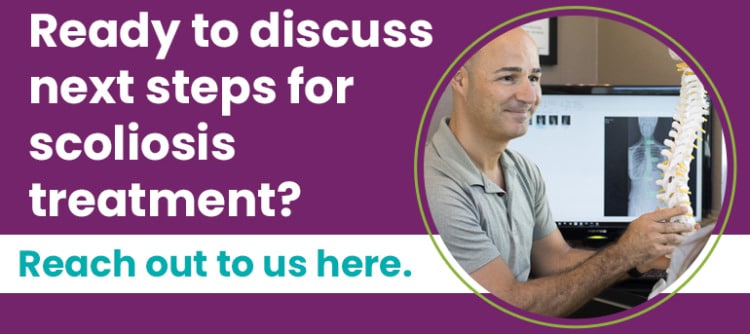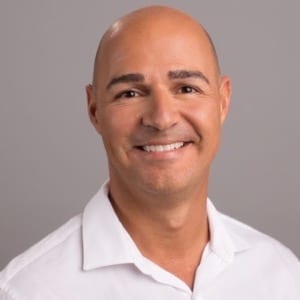Ideal Timing: What Is the Best Age to Have Scoliosis Surgery
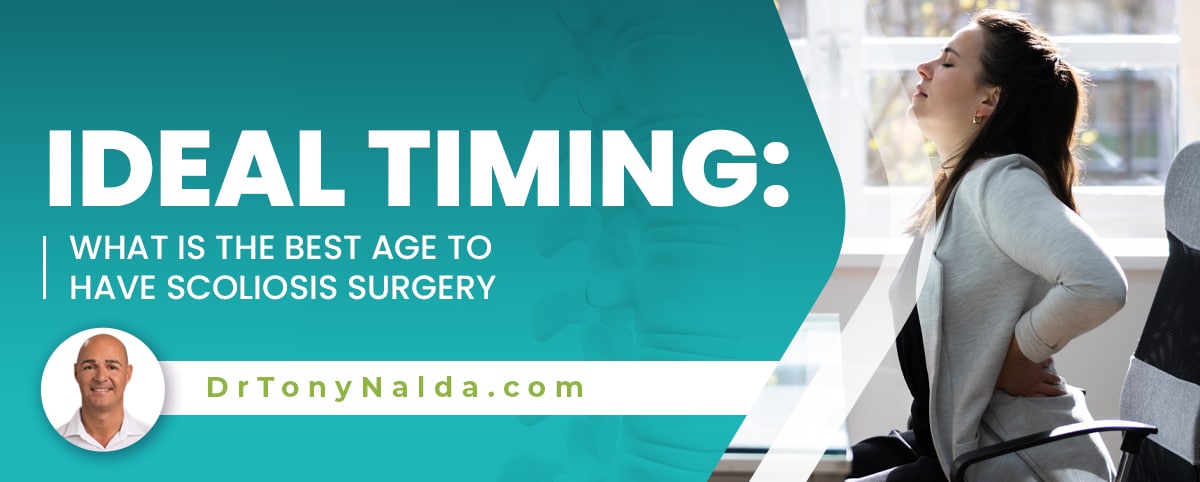
When scoliosis is first diagnosed, conditions are classified based on key patient and condition variables, one of which is condition severity. Severity is a key factor that treatment plans are shaped around. When conditions become severe at 40+ degrees, traditional treatment commonly recommends spinal fusion surgery.
There is no ideal age at which to have scoliosis surgery; this is because no two cases of scoliosis are the same. Not only does scoliosis range widely in severity, there are also different condition types. Spinal fusion is recommended when a specific level of severity is reached, not a specific age.
Let's start with how scoliosis is diagnosed and condition severity is determined.
Table of Contents
Diagnosing and Classifying Scoliosis
Diagnosing scoliosis isn't always easy; it's signs can be subtle.
Scoliosis has to be diagnosed through a combined physical examination, an Adam's forward bend test, and the results of a scoliosis X-ray.
So an X-ray has to show the spine doesn't just bend unnaturally, but also twists, and the size of the unnatural spinal curve has to be a minimum of 10 degrees.
Scoliosis is further classified based on patient age, condition type, curvature location, and severity.
Condition severity is determined by a measurement known as Cobb angle, and this is a key piece of information both for diagnosing and treating scoliosis, including determining when spinal fusion should be recommended.
Condition Severity and Scoliosis Surgery
A patient's Cobb angle is determined by drawing lines from the tops and bottoms of the curve's most-tilted vertebrae, and the resulting angle is expressed in degrees.
The higher a patient's Cobb angle, the more severe scoliosis is, the further out of alignment the spine is, and the more complex it will be to treat.
Mild scoliosis is diagnosed with Cobb angle measurements of between 10 and 25 degrees.
Moderate scoliosis is diagnosed with Cobb angles of between 25 and 40 degrees.
Severe scoliosis is diagnosed at 40+ degrees, and very severe scoliosis has measurements of 80+ degrees.
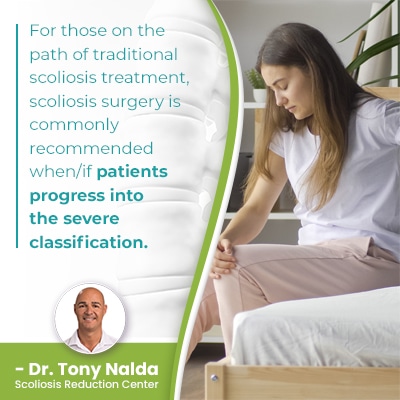 For those on the path of traditional scoliosis treatment, scoliosis surgery is commonly recommended when/if patients progress into the severe classification.
For those on the path of traditional scoliosis treatment, scoliosis surgery is commonly recommended when/if patients progress into the severe classification.
Severe curves with continued signs of progression are funneled towards surgical intervention.
What is Scoliosis Surgery?
Scoliosis surgery is a type of spinal fusion that involves fusing the curve's most-tilted vertebrae into one solid bone so they can't become more tilted, and metal rods are attached to the spine to hold it in place.
But a spine that's fused can be weaker and more vulnerable to injury, less flexible with a reduced range of motion, and more painful at the fusion site: affecting quality of life.
If spinal fusion is unsuccessful for any reason, the only recourse is additional surgery and more risks.
The reality is that most patients don't need surgical intervention, particularly when a child's spine is assessed for early detection and intervention.
So scoliosis surgery recommendations aren't based on age, but condition severity and curve progression.
Adolescent idiopathic scoliosis is the most prevalent type of scoliosis overall, diagnosed in adolescents between the ages of 10 and reaching skeletal maturity, and this age group is the most at risk for rapid phase progression because progression is triggered by growth.
Non Surgical Treatments for Scoliosis
Non surgical treatments for scoliosis are safer and less invasive than a traditional surgical treatment response.
Non surgical treatment approaches prioritize preserving as much of the spine's natural strength and function as possible.
Here at the Scoliosis Reduction Center®, patients benefit from a modern conservative treatment approach that uses a number of treatments to address conditions on every level.
Non surgical treatments can include chiropractic care, physical therapy, scoliosis-specific exercises, corrective bracing, and rehabilitation.
Chiropractic-Centered Treatment
Conservative treatment is also known as functional and/or chiropractic-centered treatment.
Condition-specific chiropractic care involves a number of techniques and manual adjustments to work towards realigning the spine by reducing the size of the unnatural spinal curve, and restoring as much of the spine's healthy curves as possible.
Reducing curve size means impacting conditions on a structural level: necessary when addressing structural spinal conditions.
Physical Therapy
Physical therapy and scoliosis-specific exercise are applied to strengthen and balance the spine's surrounding muscles for more support and stability.
The power of exercise as a facet of treatment is evident in the success of exercise-based approaches to scoliosis treatment such as the Schroth method and SEAS (Scientific Exercise Approach to Scoliosis).
Physical therapy and exercise can also help improve posture: important for sustaining a curve correction.
Corrective Bracing
Corrective bracing can help by pushing the spine into a corrective position, and as a child's spine is more malleable, bracing is a regular facet of childhood scoliosis treatment.
Spinal growth triggers progression, so children and adolescents are the most at risk for continued and rapid progression due to the unpredictable nature of growth spurts.
While traditional treatment uses bracing prior to recommending spinal fusion, traditional bracing is known for a number of shortfalls that modern corrective bracing addresses.
The ScoliBrace addresses the condition's true 3-dimensional nature and pushes the spine, instead of squeezing it unnaturally, and when combined with other types of corrective treatment, bracing can be a powerful treatment discipline.
As scoliosis can progress quickly as a child grows, counteracting progression is a focus of treatment, and many patients respond well to the combination of chiropractic care, scoliosis-specific physical therapists, corrective bracing and rehabilitation.
Rehabilitation
Rehabilitation is an important part of sustaining treatment results, and as a progressive condition, treating scoliosis is about managing an ongoing condition
Custom-prescribed scoliosis exercises designed to hold treatment results and teach postural awareness can be an important part of healing and stabilizing the spine for long-term sustainable treatment results.
Spine problems need to be addressed proactively because there is a certain amount of age-related degeneration to be expected within the spine, and if a spinal condition like scoliosis is also present, spines will experience uneven wear and tear that can increase a person's rate and level of degeneration.
The best way to avoid invasive spinal surgery is through early detection and intervention.
The Benefits of Early Detection
There are no treatment guarantees, but there is a direct link between early diagnosis, intervention, and treatment success.
The earlier scoliosis is diagnosed, the sooner treatment can be started, and as scoliosis can progress from mild scoliosis to moderate scoliosis and severe, where a patient's condition is at the time for diagnosis doesn't mean that's where it will stay.
The benefit of early detection is that it can mean early intervention, but only for those who have committed to a proactive non-surgical treatment approach; traditional scoliosis treatment doesn't have a strategy for addressing scoliosis while mild and commonly recommends merely watching and waiting.
Scoliosis progressing means the size of the unnatural spinal curve is increasing, as are the condition's effects, and the spine is becoming increasingly rigid: making it less responsive to treatment.
Smaller curves are more flexible and responsive, so why not start treatment while mild when the spine is most likely to respond well.
Another benefit to early detection is that it can mean preventing progression and increasing condition effects such as noticeable postural changes: uneven shoulders, uneven shoulder blades, and uneven hips.
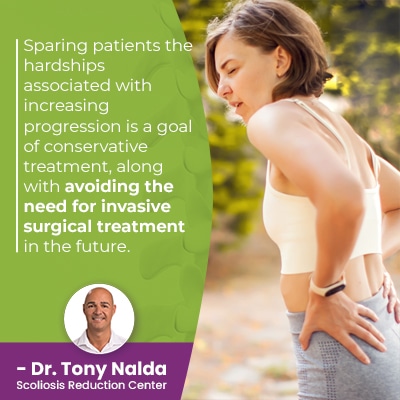 Sparing patients the hardships associated with increasing progression is a goal of conservative treatment, along with avoiding the need for invasive surgical treatment in the future.
Sparing patients the hardships associated with increasing progression is a goal of conservative treatment, along with avoiding the need for invasive surgical treatment in the future.
Conclusion
Scoliosis patients need to understand that there are two types of scoliosis treatment to choose between: surgical or non-surgical.
While traditional scoliosis treatment commonly recommends spinal fusion surgery for severe cases, modern conservative treatment has the goal of preventing cases from becoming severe.
Traditional treatment doesn't have a common age surgery is recommended for because the determining factor is condition severity and a patient's rate of progression.
If a patient has severe scoliosis and is showing signs of continued progression, traditional treatment commonly funnels patients towards scoliosis surgery.
The best age to start screening for scoliosis is prior to a child's first pubescent growth spurt because this can mean early detection and the opportunity for early intervention.
There are a number of benefits to addressing early onset scoliosis prior to significant progression because this is when spines are still flexible and responsive.
The best age to start scoliosis treatment is immediately following a diagnosis because as a progressive condition, the sooner treatment is started, the better.
Dr. Tony Nalda
DOCTOR OF CHIROPRACTIC
After receiving an undergraduate degree in psychology and his Doctorate of Chiropractic from Life University, Dr. Nalda settled in Celebration, Florida and proceeded to build one of Central Florida’s most successful chiropractic clinics.
His experience with patients suffering from scoliosis, and the confusion and frustration they faced, led him to seek a specialty in scoliosis care. In 2006 he completed his Intensive Care Certification from CLEAR Institute, a leading scoliosis educational and certification center.
About Dr. Tony Nalda
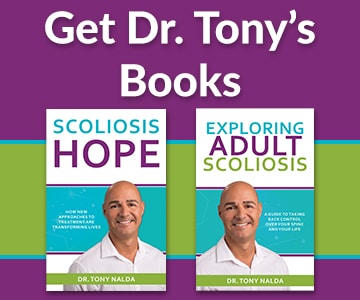 Ready to explore scoliosis treatment? Contact Us Now
Ready to explore scoliosis treatment? Contact Us Now